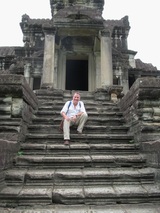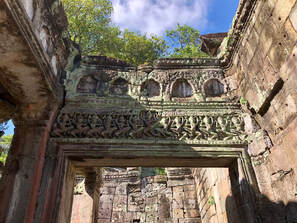|
One of the great wonders of the ancient world. Construction of Angkor Wat began during the reign of Suryavarman II (reigned 1113-c.1150) and took about thirty years to complete. A Hindu temple-city dedicated to Vishnu, Angkor Wat might also have served as a mausoleum for the king after his death. It is the most famous of all the temples of Angkor, receiving thousands of visitors each day. Buddhist monks have maintained the temple since the 16th century.
Wat Atvea is a Hindu temple dating to the late-12th or perhaps early-13th century. As no inscriptions have been found, it is not known precisely when it was dedicated or to what purpose. It has been suggested by some archaeologists that this temple was not completed. There are unfinished carvings, and many columns and lintels lack adornment. Also notable is the enormous size of the blocks used in the construction of this rather small temple. Located to the south of Siem Reap and most other Angkor sites, this temple receives little visitation. I explored the temple at length on a Saturday afternoon and was the only visitor present. A modern Buddhist pagoda is located next to the ruin site.
Preah Khan ("Sacred Sword") was built in 1191 as a monastery and school by King Jayavarman VII (reigned 1181-1220), who dedicated it to his father Dharaindravarman. This 138-acre Buddhist complex served as the nucleus of a temple community that included Neak Pean and Ta Som, which are located along Jayataka Baray, the last of the great reservoirs constructed at Angkor. The garuda is the symbolic guardian and protector of Preah Khan. There are 72 of these 5-meter high statues along the wall that surrounds Preah Khan. Each garuda holds in either hand a three-headed naga. In Hindu mythology, the half-man, half-bird figure is the mount of Vishnu and is the mortal enemy of the naga. Buddhist mythology aligns the two here as protectors of the ground and water (naga) and the heavenly realm (garuda).
Bayon is a Buddhist "temple-mountain" built by the great Khmer king, Jayavarman VII (reigned 1181-1220 CE). It is iconic among the temples of Angkor, notable for its ubiquitous towers with four faces (there are over 200 faces on 54 towers). While it is generally accepted that the faces depict the king and signify his omnipresence, some have argued that they represent the Bodhisattva Avalokiteshvara, embodiment of compassion. Given the benevolent nature of Jayavarman's rule (he built hospitals, schools, and many public works), it is possible that king envisioned himself as the Bodhisattva. The temple also contains many fine bas-reliefs depicting scenes of war (the naval victory over the Chams led by Jayavarman VII in 1181) and of daily life in ancient Angkor.
A Buddhist monastic complex built by Jayavarman VII sometime in the late 12th and early 13th centuries. No inscription stone has ever been found so it is not known precisely when it was dedicated or for whom it was built. Faultily constructed of poor quality sandstone, the ruin is crumbling. Towers are bound with cable, and various supporting structures are in place to keep the temple from further degradation. Nevertheless, the site has its own charm and enigmatic beauty. Similar in aesthetic and purpose to the nearby, but much larger, Ta Prohm, Banteay Kdei is an important Buddhist site. It has been occupied by monks for centuries, except in the 1960s when it was apparently home to a herd of dangerous wild deer. That's right. Dangerous wild deer.
|








 RSS Feed
RSS Feed


